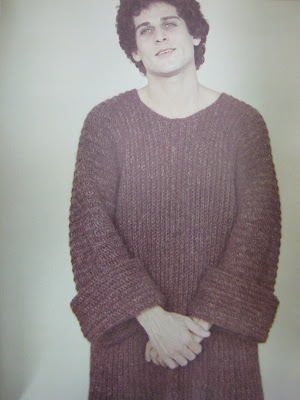
I would blush too with a be-piped young man looking at my bottom.
-Mitt Pattern from Stitchcraft Magazine 1964

 Mrs. Crawford offered 2 collars, I am making collar 1. She suggests that by altering the recommended 40 thread to a finer or coarser silk or cotton, the collar may be used as garnitures or trimming all over the place including the waist. She says that using a colour that harmonizes with your gown is "extremely pretty", but that "ecru thread may be substituted with pleasing results."
Mrs. Crawford offered 2 collars, I am making collar 1. She suggests that by altering the recommended 40 thread to a finer or coarser silk or cotton, the collar may be used as garnitures or trimming all over the place including the waist. She says that using a colour that harmonizes with your gown is "extremely pretty", but that "ecru thread may be substituted with pleasing results." I'm using white DMC #12 thread and a steel 0.75mm hook. The pattern is using many interesting and amusing techniques.
I'm using white DMC #12 thread and a steel 0.75mm hook. The pattern is using many interesting and amusing techniques. 
When double or treble crochets are needed in isolation, or if a cluster is to be worked from a chain alone it is doubly important, when working the first stitch to raise the hook perpendicular to the work to ensure that each yarn over and loop is as high as the previous stitch or loop. It's akin to Lucy Neatby's Happy Stitches in knitting. If a stitch does not have a neighbour standing next to it, it is want to lean over or even flop. In crocheted motifs and doilies, this may make the excess thread pop out the bottom. Very unattractive.
You may need to estimate the height of the first step or stitch, but as long as you yank up your hook with each of the next loops or steps of the stitch, you will have a consistent and convincing look.

What I enjoyed the most about this pattern was Mrs. Crawford's bossy but charming finishing instructions:
"All joinings were done with needle and fine thread, the writer believing this to be the better method for many reasons."
Delish! Absolutely no justification! She also gives a collar top tip;
'Have a collar-pattern and, after placing the motifs as arranged, or in any preferred way, sew with fine stitches."
Aren't patterns from this era nice in their flexibility (the joinings bit notwithstanding). I like the room these instructions give for personal taste and creativity. I also admire this period's approach to garnitures; instructions seldom assume what you're going to use the pattern, or even the item for. Indeed:







 "Modular Crochet- A Revolutionary New Method for Creating Custom-Design Pullovers" (1978)by Judith Copeland is an amazing read. If you ever get your hands on it don't let go. It mainly contains ladies pullovers and tops and is beautifuly photographed in turn of the '80s period style.
"Modular Crochet- A Revolutionary New Method for Creating Custom-Design Pullovers" (1978)by Judith Copeland is an amazing read. If you ever get your hands on it don't let go. It mainly contains ladies pullovers and tops and is beautifuly photographed in turn of the '80s period style.